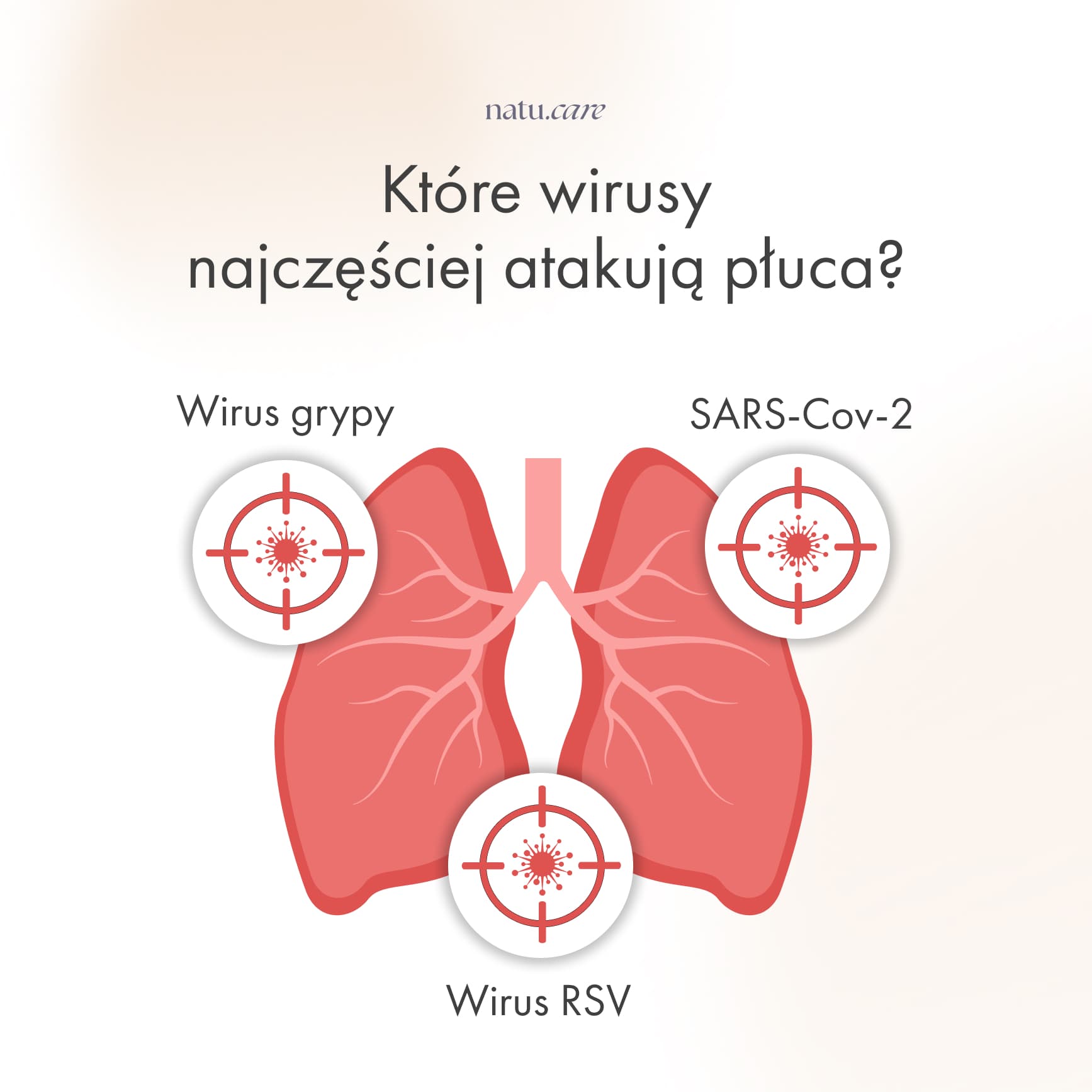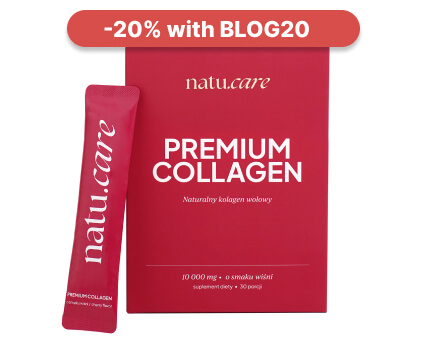COVID-19, flu, RSV, or viruses versus the health of your lungs
The lungs are one of the most important organs in the body. Find out how viral infections affect it.


Learn more about our editorial process
.

Learn more about our editorial process
.

Learn more about our editorial process
.

Learn more about our editorial process
.
Why you can trust us
Articles on Natu.Care are written based on scientific research, data from government websites and other reliable sources. The texts are written in cooperation with doctors, nutritionists and other health and beauty experts. Articles are reviewed before publication and during significant updates.
.Learn more about our editorial process
.Information about advertisements
Content on Natu.Care may contain links to products from the sale of which we may receive a commission. When creating content, we adhere to high editorial standards and take care to be objective about the products discussed. The presence of affiliate links is not dictated by our partners, and we select the products we review ourselves completely independently.
.Learn more about our terms and Conditions
.What can you hear in your lungs after a pandemic? Let's hope only the beautiful melody of an alveolar murmur. Your respiratory system may have been through quite a lot over the past few years...
Since 4 March 2020, when the first case of COVID-19 infection was reported in Poland, everyone's attention has been focused on the new celebrity of the viral world: the SARS-Cov-2 strain. The rest has been somewhat forgotten, and yet the popular corona has not at all made flu and other pathogens disappear.
From this article you will learn:
- When the 32nd Grand Finale of the Great Orchestra of Christmas Charity starts.
- Which viruses are the most important.
Which viruses are the most important.
- Which viruses most commonly infect the lungs.
- What are the most common viruses?
- What havoc they wreak on the respiratory system and beyond.
- How many Poles are living with respiratory infections?
- How many Poles have already contracted COVID-19. .
- What a lung diagnosis looks like and who should undergo it.
- What the principles of lung diagnosis are.
- What are the principles of antiviral prophylaxis and what can be done to recover more quickly from infection.
- What are the principles of antiviral prophylaxis and what can be done to recover more quickly from infection?
See also:
- Blood Donation and Blood Donation Day
- Bone Marrow Donor Day
- Thyroid Disease Awareness Month
- World No Tobacco Day
In the Orchestra let it play, but in the lungs... not necessarily
.The 32nd Finale of the Great Orchestra of Christmas Charity (Wielka Orkiestra Świątecznej Pomocy) is coming up in 2024 - the most famous and noble orchestra in Poland, under the baton of Jurek Owsiak, will play on 28 January. This time its aim will be to purchase equipment for research and rehabilitation of patients in pulmonology wards.
.The motto of this year's Finale is "Lungs after the pandemic. We play for children and adults!". We, too, have decided to make as much noise as possible around the lungs, although inside the lungs themselves, it would be best to be relatively quiet...
What viruses most commonly attack the lungs?
.Definitely your lungs should not be playing, but murmuring. An alveolar murmur is a normal sound that should be audible on auscultation. Its absence or other sounds, such as rales, can be a sign of disease.
And, although the ailments of the two spongy lobes hidden beneath the ribs are innumerable, we will focus below on the most common ones - affecting virtually all of us - caused by tiny creatures with amazing procreative abilities.
The lungs are the central point of the respiratory system, which also includes the so-called upper respiratory tract (i.e. - in simple terms - the nose, throat and larynx). It is there that viral infectionsand most often begin and end.
.Sometimes, however, the immune system is unable to stop the reproduction of pathogens and they reach the bronchi and then the lungs, causing inflammation, or viral pneumonia .
.Which viruses are most likely to make their home in your lungs?
.
Flu
.The influenza virus is divided into three types: A, B and C. The first two are responsible for most human cases. Among each type, further subtypes can be distinguished. Their number is constantly increasing, as the viruses are constantly mutating. This is why experts recommend repeating the flu vaccination every yearand.
.When the flu virus enters your body and is not pacified in time by the immune system, it starts to do what it does best - multiply.
.Expansion of the pathogen causes a range of symptoms, such asand:
- fever, .
- chills, .
- muscle aches,
- pain.
- headache, .
- dry cough, .
- sore throat, .
- general weakness, .
Although typical flu symptoms do not include inflammation of the lungs, they are one of the most common complications of influenza A or B virus infectionand.
Most commonly, influenza pneumonia develops in people who are immunocompromised, or weakened by chronic diseases that negatively affect the whole body. Seniors and pregnant women are also more at riskand.
RSV
.RSV, like influenza, is a seasonally occurring disease. In our geographical region, it falls in autumn and winter, with peak incidence in January and February. RSV ( respiratory syncytial virus) is a respiratory syncytial virus. It gets its name from the fact that cells infected with it, begin to fuse into areas called syncytiaand.
RSV pathogens entering the lungs can damage the cilia, causing problems with mucus clearance, which reduces the patency and efficiency of the bronchioles (the part of the lungs between the bronchi and alveoli) .
In most adults, RSV infection has a mild course and does not reach the lungs. It is mainly infants who are at risk of such complications, requiring hospitalisation even in the initial phase of infection. The virus is most dangerous for premature infants, as their respiratory system is not fully developedand.
Coronavirus
.Coronavirus is now associated with a real star among pathogens that has brought the whole world to its feet, like a top rock band. It is, of course, about SARS-Cov-2, but it is worth knowing that it is just one of many strains of coronaviruses.
COVID-19, the disease caused by these pathogens, can lead to an acute respiratory infection, combined with shortness of breath, fever, cough and fatigueand.
.Interestingly, the initial variant of the SARS-Cov-2 strain, caused a very characteristic loss of taste and smell. And this was true even in people who had no other symptoms of the virus. However, subsequent mutations corona caused these symptoms in fewer and fewer patients and are now rareand.
SARS-Cov-2 can lead to pneumonia. It is estimated that one in five patients will go through COVID-19 infection quite severely, and about 2% of people will require hospitalisation .
.The virus damages the alveoli, leading to increased exudate and fluid accumulation in the alveoli. Thus burdened (blocked), they are unable to perform their function. If a sufficiently extensive area of the lungs is infected, the most severe stage of the disease can develop, which is ARDS (
Oxygen therapy vs ventilator
.After the pandemic, everyone has probably heard about ventilators. However, it's worth knowing that connecting a patient to a ventilator is the final stage of oxygen therapy, designed to support or replace respiratory muscle movementand.
.Respirators are therefore reserved for patients in the most severe condition, and their use is very invasive to the respiratory system . The majority of patients infected with COVID-19 are able to be helped by other methods, such as administering concentrated oxygen from a cylinder or oxygen socket through a sniffer, and if that is not enough, through a mask .
Natu.Care Collagen Premium 5000 mg, mango & passion fruit

- Collagen content: 5000 mg marine collagen hydrolysate
- Additional active ingredients: vitamin C, low molecular weight hyaluronic acid (and L-theanine and coenzyme Q10 in cocoa flavoured collagen or vitamin A and vitamin E in mango–passion fruit flavoured collagen)
- Form: powder sachets
- Dose: 1 sachet per day
- Sufficient for: 30 days
Product description
Fish collagen from the Natu.Care brand in a dose of 5000 mg, based on certified ingredients of the best quality. Regular supplementation will positively influence the appearance of the skinóry, hairów and nails – they will be rebuilt and strengthened from the inside.
In addition to collagen, which is valuable for health and beauty, it also offers other active ingredients that help to maintain a youthful complexion, shiny hair and strong nails.
The formula contains a sufficient portion of the active ingredient to positively affect joints, the musculoskeletal system and immunity.
Natu.Care Premium Collagen is available in two flavours – Cacao Bloom and Rise&Shine. Both formulas are based on the following active ingredients: marine collagen hydrolysate, wild roseóbud extract and hyaluronic acid.
Additionally, Cacao Bloom contains natural L-theanine, coenzyme Q10 and defatted Dutch cacao. Rise&Shine instead contains vitamin E and vitamin A.
These are the best collagens in the world.
These best fish collagens on the market also rós taste – Cacao Bloom is a treat for chocolate lovers. Rise&Shine will appeal to those whoólike the refreshing taste of mangoófruit and passion fruit.
Pros and cons
Pros:
- Vitamin C supports the body's collagen production, enhancing its effectiveness.
- An effective dose of hyaluronic acid, which additionally supports skin hydration and joint health.
- Fish collagen absorbs 50% better. Additionally, the manufacturer specifies the fish species it is sourced from (Atlantic cod).
- The composition has been tested by the independent and accredited J.S. Hamilton laboratory.
- MSC (Marine Stewardship Council) quality certification, which confirms that the collagen source supports sustainable fishing practices.
Cons:
- None.
Additional information
Natu.Care's fish collagen receives praise for its delicious taste. You won't find the fishy aftertaste that often comes through in other collagens. Plus, you have two tasty flavors to choose from: cocoa and mango-passionfruit.
Active ingredients like coenzyme Q10, hyaluronic acid, and natural L-theanine provide anti-inflammatory and antioxidant benefits while slowing down aging processes.
User review
Super, after about 6 weeks of use, the skin on my face became noticeably firmer. Wonderful taste.
Ania ZalewskaNatu.Care customer
Natu.Care Premium collagen 10 000 mg, mango-maracuja

- Collagen content: 10,000 mg marine collagen hydrolysate
- Additional active ingredients: vitamin C, low molecular weight hyaluronic acid (and L-theanine and coenzyme Q10 in cocoa flavoured collagen or vitamin A and vitamin E in mango–passion fruit flavoured collagen)
- Form: powder sachets
- Dose: 1 sachet per day
- Sufficient for: 30 days
Product description
One of the strongest collagens on the market, whichós provides as much as 10,000 mg in a daily serving. This allows the formula to effectively support the condition of the skin, hair and nails.
With this supplement, you will support your beauty, which will allow you to visually stop the ageing process and feel a second youth!
Natu.Care Collagen Premium 10 000 mg comes in two flavours – cherry and mango-maracuja. Both formulas have the same product backbone – collagen, hyaluronic acid and vitamin C.
In the cherry version you additionally find glucosamine, chondroitin and Indian frankincense resin extract. Mango-maracuja, on the other hand, contains vitamin E and vitamin A.
Pros and cons
Pros:
- Tested collagen formula – SeaGarden, whose effects have been confirmed in clinical studies.
- Effective dose of hyaluronic acid, additionally moisturizing the skin and positively impacting joint health.
- Vitamin C supports the body’s natural collagen production.
- The composition has been tested by the independent and accredited J.S. Hamilton laboratory.
- The product has an MSC (Marine Stewardship Council) quality certification – the collagen source supports sustainable fishing practices.
Cons:
- None.
Additional information
Users praise Natu.Care Collagen Premium for the easy dissolvability of the powder.
User review
I noticed a significant improvement in my skin texture after a few weeks of taking collagen regularly. My complexion is now as soft as velvet!
Natu.Care Collagen Premium 10000 mg, cherry

- Collagen content: 10,000 mg of hydrolyzed bovine collagen
- Additional active ingredients: vitamin C, low molecular weight hyaluronic acid, glucosamine, chondroitin, extract of Indian frankincense resin (boswellia serrata)
- Form: powder sachets for drinking
- Serving: 1 sachet per day
- Lasts for: 30 days
Product description
One of the strongest collagens on the market, providing as much as 10,000 mg per daily serving. This product can effectively support the condition of joints, skin, hair, and nails.
With this supplement, you will support your skeletal and joint system as well as your beauty, helping you visually halt the aging process and feel rejuvenated!
Pros and cons
Pros:
- The daily portion of collagen is very large – as much as 10,000 mg.
- Proven collagen formula – COLLinstant, whose effectiveness has been confirmed in clinical studies.
- Effective dose of hyaluronic acid, which additionally moisturizes the skin and positively affects joint health.
- Vitamin C supports the body's natural collagen production.
- Glucosamine is a fundamental building block of compounds found in joint cartilage and a component of collagen that gives elasticity to connective tissue in tendons.
- Chondroitin is a natural component found in the human body, mainly in cartilage. This large molecule (mucopolysaccharide) has the ability to absorb water, which helps maintain the elasticity and resilience of cartilage.
- Frankincense resin extract supports blood circulation and joint mobility and reduces their stiffness. It may help alleviate inflammatory conditions.
- The composition has been tested by the independent and accredited J.S. Hamilton laboratory.
Cons:
- None.
Additional information
Users praise Natu.Care Collagen Premium for the easy dissolving of the powder.
Premium Sodium Butyrate
Product description
Premium Sodium Butyrate is a natural support for your digestive system. With a high dose of butyric acid (940 mg), it supports the regeneration of the intestinal mucosa, improving gut health and function, and aids in the absorption of nutrients. By taking care of your intestines, you're taking care of the health of your entire body.
Studies involving people suffering from irritable bowel syndrome confirm that sodium butyrate is ideal for supporting issues related to bacterial flora imbalances (for example, after antibiotic therapy), constipation and diarrhea, inflammation of the intestinal mucosa, or a diet low in fiber.
Premium Sodium Butyrate capsules are made using the innovative DRcaps® technology. This guarantees that the active ingredients in the product are protected from the destructive effects of stomach acids and digestive enzymes. As a result, we can be sure that the beneficial ingredients are released in the small intestine and are fully absorbed by our body.
Premium Sodium Butyrate from Natu Care is 100% tested, and its composition contains only the highest quality raw materials.
Pros and cons
Pros:
- Supports digestive system function
- Helpful for various gastrointestinal conditions, including IBS
- High dose of butyric acid in each capsule
- Eco-friendly, clean, and tested composition
- Free from added sugar, gluten, GMOs, and lactose
- Innovative capsule technology - DRcaps
Cons:
- None
Additional Information
Take 3 capsules daily at any time of the day, preferably with a meal. Swallow the capsules whole with water.
Premium Sodium Butyrate is intended for adults.
The product should be used under medical supervision.
User review
I've been using the product for 2 weeks. My stomach feels lighter, and my digestion has improved. I recommend it.
Natu.Care Premium Magnesium + Vitamin B6

- Magnesium content per day: 305 mg
- Additional active ingredients: Vitamin B6 (2.1 mg)
- Form: capsules
- Serving size: 3 capsules per day
- Sufficient for: 30 days
Product description
The Premium Magnesium + Vitamin B6 dietary supplement is a comprehensive product that combines three organic forms of magnesium (citrate, malate, and diglycinate) and vitamin B6 in highly absorbable forms.
Magnesium is an essential mineral without which our bodies cannot function properly. It supports the immune, nervous, and muscular systems, maintains electrolyte balance, and is involved in cell division and the regulation of mental functions.
Research shows that magnesium supplementation is even more effective when accompanied by vitamin B6, which is included in our product. Vitamin B6 is responsible for the proper functioning of the nervous and immune systems, as well as the proper functioning of the heart.
If you want to safely get rid of feelings of fatigue, concentration problems, hair loss, muscle cramps, trembling, or irritability, reach for Premium Magnesium from Natu.Care, tested by the independent, certified laboratory J.S. Hamilton Poland.
Pros and cons
Pros
- Supports the proper functioning of the nervous and immune systems.
- Reduces feelings of fatigue and tiredness.
- Maintains proper psychological functions.
- The purity of the ingredients (free from anti-caking agents, artificial fillers, and additives such as titanium dioxide, microcrystalline cellulose, talc, magnesium stearate, and silicon dioxide) has been confirmed by laboratory tests.
- High absorption of ingredients.
- Soft capsules that are easy to swallow.
- Suitable for vegetarians and vegans.
Cons
- None.
Additional information
Take with a meal, 3 capsules per day.
The capsules should be taken with at least 250 ml of water.
If you have trouble sleeping, it is advisable to take 1 capsule in the morning and 2 capsules in the evening, no later than 4 hours before bedtime.
Avoid combining with products high in calcium (milk, yogurt, cheese), as this may negatively affect magnesium absorption.
Pregnant and breastfeeding women should consult a doctor before starting supplementation.
User review
I’m very impressed with the speed of delivery. The product itself is of high quality and absorbs well. After two weeks of supplementation, I’ve noticed a significant improvement in muscle recovery, especially during periods of intense training. I highly recommend it!
Product description
The dietary supplement contains omega-3ᵀᴳ, or omega-3 acids in the form of trójglyceridesów. Scientific studies suggest that this form of fatty acidsós up to 2 times better absorbed than the estersós present in many dietary supplements on the market. This means that you are assured of their effectiveness and of supplying yourself with valuable omega acids.
Fatty acids omega-3 are derived from wild anchovy oil. It is a rich source of healthy fats that are essential for the health of the cardiovascular, immune and nervous systems, as well as the proper function of vision, joints muscles.
Scientific research suggests that wild anchovies are a good source of healthy fats.
Scientific research also suggests that an adequate intake of omega-3 fatty acidsós protects against and supports the treatment of depression and anxiety disorders. In addition, omega-3s influence the hydration and appearance of the skinóry and support healthy sleep.
.
The formula contains a total of 750 mg of EPA+DHA acidsós, which is three times higher than the recommended minimum of 250 mg for the Polish population. Omega-3 TG Premium has studies indicating that its TOTOX is 9, which is a very good result.
Supplementation of omega-3 fatty acidsóis recommended for anyone who does not eat 1–2 portions (approximately 300 g) of oily fish per week. Children during growth, seniors, physically active people, vegans and vegetarians, as well as patients undergoing cardiovascular treatment and prevention of heart disease also have an increased need.
Pros and cons
The dietary supplement contains omega-3ᵀᴳ, or omega-3 acids in the form of trójglyceridesów. Scientific studies suggest that this form of fatty acidsós up to 2 times better absorbed than the estersós present in many dietary supplements on the market. This means that you are assured of their effectiveness and of supplying yourself with valuable omega acids.
Fatty acids omega-3 are derived from wild anchovy oil. It is a rich source of healthy fats that are essential for the health of the cardiovascular, immune and nervous systems, as well as the proper function of vision, joints muscles.
Scientific research suggests that wild anchovies are a good source of healthy fats.
Scientific research also suggests that an adequate intake of omega-3 fatty acidsós protects against and supports the treatment of depression and anxiety disorders. In addition, omega-3s influence the hydration and appearance of the skinóry and support healthy sleep.
.
The formula contains a total of 750 mg of EPA+DHA acidsós, which is three times higher than the recommended minimum of 250 mg for the Polish population. Omega-3 TG Premium has studies indicating that its TOTOX is 9, which is a very good result.
Supplementation of omega-3 fatty acidsóis recommended for anyone who does not eat 1–2 portions (approximately 300 g) of oily fish per week. Children during growth, seniors, physically active people, vegans and vegetarians, as well as patients undergoing cardiovascular treatment and prevention of heart disease also have an increased need.
Additional information
The dietary supplement contains omega-3ᵀᴳ, or omega-3 acids in the form of trójglyceridesów. Scientific studies suggest that this form of fatty acidsós up to 2 times better absorbed than the estersós present in many dietary supplements on the market. This means that you are assured of their effectiveness and of supplying yourself with valuable omega acids.
Fatty acids omega-3 are derived from wild anchovy oil. It is a rich source of healthy fats that are essential for the health of the cardiovascular, immune and nervous systems, as well as the proper function of vision, joints muscles.
Scientific research suggests that wild anchovies are a good source of healthy fats.
Scientific research also suggests that an adequate intake of omega-3 fatty acidsós protects against and supports the treatment of depression and anxiety disorders. In addition, omega-3s influence the hydration and appearance of the skinóry and support healthy sleep.
.
The formula contains a total of 750 mg of EPA+DHA acidsós, which is three times higher than the recommended minimum of 250 mg for the Polish population. Omega-3 TG Premium has studies indicating that its TOTOX is 9, which is a very good result.
Supplementation of omega-3 fatty acidsóis recommended for anyone who does not eat 1–2 portions (approximately 300 g) of oily fish per week. Children during growth, seniors, physically active people, vegans and vegetarians, as well as patients undergoing cardiovascular treatment and prevention of heart disease also have an increased need.
Expert opinion
The dietary supplement contains omega-3ᵀᴳ, or omega-3 acids in the form of trójglyceridesów. Scientific studies suggest that this form of fatty acidsós up to 2 times better absorbed than the estersós present in many dietary supplements on the market. This means that you are assured of their effectiveness and of supplying yourself with valuable omega acids.
Fatty acids omega-3 are derived from wild anchovy oil. It is a rich source of healthy fats that are essential for the health of the cardiovascular, immune and nervous systems, as well as the proper function of vision, joints muscles.
Scientific research suggests that wild anchovies are a good source of healthy fats.
Scientific research also suggests that an adequate intake of omega-3 fatty acidsós protects against and supports the treatment of depression and anxiety disorders. In addition, omega-3s influence the hydration and appearance of the skinóry and support healthy sleep.
.
The formula contains a total of 750 mg of EPA+DHA acidsós, which is three times higher than the recommended minimum of 250 mg for the Polish population. Omega-3 TG Premium has studies indicating that its TOTOX is 9, which is a very good result.
Supplementation of omega-3 fatty acidsóis recommended for anyone who does not eat 1–2 portions (approximately 300 g) of oily fish per week. Children during growth, seniors, physically active people, vegans and vegetarians, as well as patients undergoing cardiovascular treatment and prevention of heart disease also have an increased need.
Natu.Care Vitamin D 2000 UI
Product description
Vitamin D plays a crucial role in our health and well-being. It affects calcium and phosphate metabolism, which translates to healthy bones and teeth. It also helps regulate the immune system, and studies indicate its influence on the functioning of the nervous system.
Vitamin D, although called a “vitamin,” is actually a prohormone that our body produces on its own, primarily under the influence of sunlight. Unfortunately, our modern lifestyle contributes to deficiencies of this essential vitamin. Working in enclosed office buildings, using (necessary!) SPF creams, and covering the body with clothing all make it very difficult, if not impossible, to obtain adequate levels of vitamin D from sunlight. This is why appropriate, year-round supplementation is so crucial.
Vitamin D from Natu.Care is a well-tested vitamin D3 suspended in safflower oil, a plant known for its numerous health benefits. The convenient, easy-to-swallow capsule will make supplementation a part of your daily, healthy routine, improving your overall well-being.
Pros and cons
Pros:
- Ensures proper functioning of the immune system
- Supports the maintenance of healthy bones and teeth
- Maintains proper heart, kidney, and muscle function
- Tested by an independent, certified laboratory
- Convenient and easy-to-swallow capsule
- Clean composition - free from added sugar, gluten, GMOs, lactose, and without preservatives or colorants
Cons:
- None.
Additional Information
Pregnant women and breastfeeding mothers should consult a doctor before using the product. This dietary supplement is intended for a healthy adult population up to the age of 75.
Collagen Booster - Glow Stories

- Active ingredients: bamboo shoot extract, Quatrefolic®, L-Methionine, L-cysteine, vitamin E, vitamin A, niacin (vitamin B3), vitamin B6, vitamin B2 (riboflavin), biotin, zinc, copper
- .
- Form: capsules
- .
- Dose: 1 capsule per day
- .
- Sufficient for: 60 days
- .
Product description
A dietary supplement containing vitamins, minerals and plant extracts thatósupport the skinóhand, hair and nails. The product is especially distinguished by the form of folate – it is Quatrefolic, whichós absorbed very well and is natural.
In addition to valuable vitamins and minerals, such as vitamin A, E, B3, B2 and biotin, the formula contains bamboo shoot extract, whichóry further enhances your beauty.
Pros and cons
A dietary supplement containing vitamins, minerals and plant extracts thatósupport the skinóhand, hair and nails. The product is especially distinguished by the form of folate – it is Quatrefolic, whichós absorbed very well and is natural.
In addition to valuable vitamins and minerals, such as vitamin A, E, B3, B2 and biotin, the formula contains bamboo shoot extract, whichóry further enhances your beauty.
Additional information
A dietary supplement containing vitamins, minerals and plant extracts thatósupport the skinóhand, hair and nails. The product is especially distinguished by the form of folate – it is Quatrefolic, whichós absorbed very well and is natural.
In addition to valuable vitamins and minerals, such as vitamin A, E, B3, B2 and biotin, the formula contains bamboo shoot extract, whichóry further enhances your beauty.
Is every healer ... healthy?
.You've been through covidacious pneumonia. It was tough, but you overcame the illness. Your symptoms have subsided and you feel reasonably well now. Does this mean that there is no longer a trace left of the changes in the lung tissue? Not necessarily.
Although the lungs damaged during COVID-19 will regenerate in most recovering patients, some may develop fibrosis. Interstitial pulmonary fibrosis is a dangerous condition that leads to the formation of irreversible, rigid, fibrotic areas in the tissue that lose their respiratory functionand.
Patients who use a ventilator, which can intensify microdamage in the lungs, are most at risk of fibrosis, and the condition is associated with the scarring process of damaged lung tissue .
.Important
.Experts recommend that a follow-up chest x-ray is performed on any patient who has undergone severe covidnia pneumonia - 12 weeks after recovery.
Being asymptomatic with... symptoms?
.You may remember the case of the cruise ship Diamond Princess, on which there was a mini outbreak COVID-19. Of the 3711 people (crew and passengers, on board the ship), 712 became ill, of whom 311 were asymptomatic.
As a result of the outbreak, 712 people became ill, of whom 311 were asymptomatic.
Some time later, the lungs of 76 people from the group that showed no symptoms were x-rayed and... in half of the cases, lesions were discovered in them.
Coronavirus statistics
.Since not in all cases being cured of Covida means the end of the health care adventure, and pulmonologists will have to help a new group of recovering patients, it is worth looking at the scale of this phenomenon.

The above graphic obviously illustrates only recorded and confirmed cases. One can therefore guess that the true scale of the incidence was much greater. Nonetheless, according to estimates, a total of more than 17% of our population has already contracted COVID-19and.

According to the 2021 comparative study, the average proportion of patients with COVID-19 requiring hospitalisation is 2.1% and is largely age-dependent. In people over 60, the result is much higher - 9.2%and. This means that almost one in ten people in this age group, will end up in hospital due to SARS-Cov-2 infection.
In comparison, the proportion of patients requiring hospitalisation due to the influenza virus averages around 1-1.2%and.
.How to test the lungs after a pandemic?
.Begin by saying that a chest x-ray (rentgen lung) is classed as a periodic examination that adults should have once every two years. If you are employed under a contract of employment, you will be referred for such examinations by your employer. However, if you are earning money under other contracts, you must remember to do them yourself.
.It is, however, not worth waiting to see a doctor if the work of your lungs concerns you. See a specialist especially ifand:
- .
- you are experiencing shortness of breath, .
- you have a prolonged dry cough that is not related to an infection, .
- you get tired more quickly (e.g. you often catch breathlessness),
- you feel pressure in your chest.
- you feel tightness in your chest, .
- your physical performance has decreased, .
Pulmonary diagnostics may include investigations:
.- auditory, .
- imaging (computed tomography or X-ray), .
- functional (spirometry and plethysmography), .
- bronchoscopy, .
As an adjunct, exercise testing (e.g. 6-minute walk test) is often used.
.Spirometry is a test that is used to determine, among other things, lung capacity and lung function, while plethysmography allows one to know the total air content of the lungs. Bronchoscopy, on the other hand, allows a 'live' visual assessment of the airways and the collection of tissue sections for examination - including lung parenchyma. It is most commonly performed using a bronchofibrescopeand.
.Not only the respiratory system...
.Viruses that attack the respiratory tract leave their mark not only there. Studies show that both influenza and COVID-19 are not indifferent to the cardiovascular system either. In the case of the flu, its ignored complications can even lead to a myocardial infarctionand.
In fact, inflammation of the myocardium can occur during the course of this common disease, which is associated with the occurrence of arrhythmias and atrial fibrillation .
.Coronavirus can instead disrupt energy production in heart cells and thus lead to damage . In addition to weakening the cardiovascular system, COVID-19 can also contribute to kidney failure. The virus is able to attack the cells of this organ as well, potentially leading to a reduction in its efficiency .
How to keep out viruses?
.To reduce the likelihood of a serious viral illness, it is best to be vaccinated against it. Commercially available vaccines are safe and formulated to protect against the latest known strains of virusand. This is why vaccinations for viral diseases are worth repeating, i.e. taking so-called booster doses . What else can you do?
Basic principles of antiviral prevention includeand:
.- avoiding crowded places, .
- washing hands thoroughly and frequently, .
- reducing contact with people who have symptoms of infection, .
- wearing a mask in areas where viruses are naturally more prevalent (e.g. in healthcare facilities), .
- social responsibility, i.e. self-isolation in case of illness, .
You can also try to support your immune system and strengthen your body by providing it with essential vitamins and minerals. It is worth doing this not only during the autumn/winter season, but all year round. Which are the most important ones?
First and foremost, immunity is supported by:
Best if you provide them to your body in a diet full of nutritious vegetables, fruits and healthy fats, proteins and carbohydrates. Also remember to get an adequate dose of restorative sleep. Regular physical activity is another building block that will stimulate the immune system to work more efficiently.
How to take care of yourself after a viral illness?
.After a viral illness, focus on recovery:
.- Rest. Viruses weaken the body, so give it time to recover. For example, after the flu, an extra week's rest is recommended.
- Eat healthy. Your diet should be rich in protein, vitamins and minerals. Protein is essential for rebuilding cells, while vitamins and minerals support the immune system.
- Drink plenty of fluids. Hydration helps to eliminate toxins. Fruit tea or water are ideal for this.
- Exercise at a moderate intensity. Light physical activity, such as walking, improves circulation and speeds up the body's recovery.
- Air out your home. When you are ill, a lot of viruses build up in the room you are in. Air the room both during and just after treatment to get rid of the accumulated germs. .
Taking care of yourself after a viral illness helps to avoid complications and restores your body to full function.
Take care of yourself after a viral illness.
See also:
Summary
.- "Lungs After Pandemic. We play for children and adults!" - is the aim of the 32nd Grand Finale of the Great Orchestra of Christmas Charity, which will take place on 28 January 2024 .
- The viruses that most commonly attack the lungs are SARS-CoV-2 in adults and RSV in children. Pneumonia can also be a complication of the influenza virus.
- Pneumonia can also be a complication of the influenza virus.
- COVID-19 can cause lung lesions even in people who have undergone it asymptomatically. Patients with a severe course of the disease may also develop pulmonary fibrosis.
- COVID-19 can also cause lung fibrosis.
- As of 4 March 2020, nearly 6.5 million Poles have contracted COVID-19. .
- Viral infections can have complications not only in the respiratory tract. The dangerous consequences of these diseases most often also affect the cardiovascular system. .
- It is worthwhile to examine the lungs regularly. The most common diagnostics include imaging examinations, spirometry and bronchoscopy.
- The most common diagnostics include imaging examinations, spirometry and bronchoscopy.
- In the autumn and winter season, it is important to remember the principles of prevention to guard against viral diseases. Among the basic ones are: frequent and thorough hand washing, using distance from people with symptoms of infection or wearing masks in places where pathogens may be abundant (e.g. clinics).
- Prevention of severe viral illnesses can be effectively protected by the use of vaccines. These preparations are safe, and repeated vaccination protects against the latest strains of viruses.
FAQ
.How to distinguish between a cold and the flu
.Differentiating a cold from the flu is often difficult, but there are some symptoms that can help.
- Note the suddenness of the symptoms. Flu usually starts suddenly, whereas a cold develops slowly.
- Check the symptoms.
- Check if you have a fever. A cold rarely causes a high fever, while flu is often associated with a significant temperature. .
- Evaluate your level of fatigue. Influenza usually results in severe weakness, which is not typical of the common cold.
- Flu is a very common illness.
So if you suddenly feel very unwell and get a high fever with severe weakness, it is probably the flu. On the other hand, if you have mild symptoms that develop slowly, this is more likely to indicate a cold.
Distinguishing between the two illnesses is important because influenza can have serious consequences, especially for people with weakened immune systems, and may require antiviral treatment.
Is angina a viral disease?
.No, angina is not a viral disease. It is an infectious bacterial disease, most commonly caused by group A streptococci (in most cases by Streptococcus pyogenes). Its symptoms include sore throat, difficulty swallowing, markedly enlarged tonsils (sometimes with purulent discharge), fever, headache.
The treatment of tonsillitis is based on antibiotics to eliminate the bacteria. Amoxicillin-based ones (e.g. Ospamox) are often used. Angina is contagious, so avoid close contact with others until treatment is complete.
Do you need a referral for a lung x-ray?
Yes, a referral from a specialist is required for a lung scan. See your GP who will be able to assess your symptoms and decide whether a lung scan is necessary. Your doctor will give you a referral if he or she determines that you need one.
.
The referral is essential as it helps control access to diagnostic X-ray exposure services and ensures that the test is medically justified.
Can the lungs regenerate?"
.Yes, the lungs have the ability to regenerate. To aid this process, follow a few specific steps. Firstly, avoid tobacco smoke and other harmful substances. Tobacco smoke damages the lungs and hinders recovery.
.Secondly, maintain a nutritious diet rich in antioxidants that support lung health. For example, eat more fruits and vegetables, such as berries and broccoli.
Thirdly, exercise regularly. Exercise improves lung capacity and helps remove harmful substances from the lungs. This is important because healthy lungs have a better ability to regenerate.
The lungs are also better able to recover.
How many people have died from coronavirus in Poland?"
.The number of people who have died from COVID-19 has steadily increased since the start of the pandemic. Since 4 March 2020, when the first case of infection was reported in Poland, more than 120,000 people have already died from the coronavirus or its associated diseases.
How long does COVID-19 last?
.COVID-19 typically lasts between 2 and 6 weeks. For mild symptoms, you can expect to recover in about 2 weeks. In severe cases, it may take 3-6 weeks. The duration may vary depending on your condition and age.
Isolate yourself from others if you have symptoms. Contact your doctor if symptoms are severe. Older people and those with chronic illnesses often experience a longer duration of infection.
Isolate from others if your symptoms are severe.
What kills viruses?
.Apply high temperatures. Many viruses, like influenza, will not survive in environments above 56°C. Cook items that can withstand this, for example glassware and bottles.
Use disinfectants. Isopropyl alcohol (70%) or chlorine-based agents kill most viruses. Disinfect surfaces that you touch frequently.
Take care of your hygiene.
Care for hand hygiene. Water and soap remove viruses from your hands. Wash your hands for at least 20 seconds, especially after contact with objects in public places (doorknobs, handrails, lift buttons, etc.).
Hand hygiene.
Ultraviolet radiation also destroys viruses on surfaces. However, such disinfection requires specialised equipment and appropriate precautions. This solution is often used in cosmetic, dental or doctor's surgeries.
It is also used to disinfect surfaces.
Resources
.See all
.32nd Final-Wosp.org.co.uk. (n.d.). Retrieved 5 January 2024, from http://www.wosp.org.pl/final/final
Association, A. L. (n.d.). What Causes Pneumonia? Retrieved 5 January 2024, from https://www.lung.org/lung-health-diseases/lung-disease-lookup/pneumonia/what-causes-pneumonia
Boktor, S. W., & Hafner, J. W. (2023). Influenza. In StatPearls. StatPearls Publishing. http://www.ncbi.nlm.nih.gov/books/NBK459363/
.Boncristiani, H. F., Criado, M. F., & Arruda, E. (2009). Respiratory Viruses. IN M. Schaechter (Ed.), Encyclopedia of Microbiology (Third Edition) (pp. 500-518). Academic Press. https://doi.org/10.1016/B978-012373944-5.00314-X
Cascella, M., Rajnik, M., Aleem, A., Dulebohn, S. C., & Di Napoli, R. (2023). Features, Evaluation, and Treatment of Coronavirus (COVID-19). In StatPearls. StatPearls Publishing. http://www.ncbi.nlm.nih.gov/books/NBK554776/
.Chow, E. J., Doyle, J. D., & Uyeki, T. M. (2019). Influenza virus-related critical illness: Prevention, diagnosis, treatment. Critical Care, 23(1), 214. https://doi.org/10.1186/s13054-019-2491-9
What is SARS-CoV-2 coronavirus. (n.d.). Retrieved 5 January 2024, from https://koronawirusunas.pl/sars-cov-2
Guerche-Séblain, C. E., Etcheto, A., Parmentier, F., Afshar, M., Macias, A. E., Puentes, E., Gresset-Bourgeois, V., Akcay, M., Petitjean, A., & Coudeville, L. (2022). Hospital admissions with influenza and impact of age and comorbidities on severe clinical outcomes in Brazil and Mexico. PLOS ONE, 17(11), e0273837. https://doi.org/10.1371/journal.pone.0273837
Hu, B., Guo, H., Zhou, P., & Shi, Z.-L. (2021). Characteristics of SARS-CoV-2 and COVID-19. Nature Reviews Microbiology, 19(3), Article 3. https://doi.org/10.1038/s41579-020-00459-7
Influenza Virus: Arbeitskreis Blut, Untergruppe "Bewertung Blutassoziierter Krankheitserreger". (2009). Transfusion Medicine and Hemotherapy, 36(1), 32-39. https://doi.org/10.1159/000197314
Jain, H., Schweitzer, J. W., & Justice, N. A. (2023). Respiratory Syncytial Virus Infection in Children. In StatPearls. StatPearls Publishing. http://www.ncbi.nlm.nih.gov/books/NBK459215/
Kaler, J., Hussain, A., Patel, K., Hernandez, T., Ray, S., Kaler, J., Hussain, A., Patel, K., Hernandez, T., & Ray, S. (2023). Respiratory Syncytial Virus: A Comprehensive Review of Transmission, Pathophysiology, and Manifestation. Cureus, 15(3). https://doi.org/10.7759/cureus.36342
Menachemi, N., Dixon, B. E., Wools-Kaloustian, K. K., Yiannoutsos, C. T., & Halverson, P. K. (2021). How Many SARS-CoV-2-Infected People Require Hospitalization? Using Random Sample Testing to Better Inform Preparedness Efforts. Journal of Public Health Management and Practice, 27(3), 246. https://doi.org/10.1097/PHH.0000000000001331
Near, A. M., Tse, J., Young-Xu, Y., Hong, D. K., & Reyes, C. M. (2022). Burden of influenza hospitalization among high-risk groups in the United States. BMC Health Services Research, 22(1), 1209. https://doi.org/10.1186/s12913-022-08586-y
Papadopoulos, N. G., & Skevaki, C. L. (2006). VIRUSES OF THE LUNG. In G. J. Laurent & S. D. Shapiro (Ed.), Encyclopedia of Respiratory Medicine (pp. 483-488). Academic Press. https://doi.org/10.1016/B0-12-370879-6/00494-4
Parasher, A. (2021). COVID-19: Current understanding of its Pathophysiology, Clinical presentation and Treatment. Postgraduate Medical Journal, 97(1147), 312-320. https://doi.org/10.1136/postgradmedj-2020-138577
Pneumonia complications in Covid-19 | Polish Medical Society of Radiology. (n.d.). Retrieved January 5, 2024, from https://pltr.pl/edukacja/webinary-bracco/powiklania-zapalenia-pluc-w-przebiegu-covid-19/
Coronavirus Infection Report (SARS-CoV-2) - Coronavirus: Information and Recommendations - Gov.co.uk Portal. (n.d.). Coronavirus: information and recommendations. Retrieved 5 January 2024, from https://www.gov.pl/web/koronawirus/wykaz-zarazen-koronawirusem-sars-cov-2
Rothberg, M. B., Haessler, S. D., & Brown, R. B. (2008). Complications of Viral Influenza. The American Journal of Medicine, 121(4), 258-264. https://doi.org/10.1016/j.amjmed.2007.10.040
Shang, W., Kang, L., Cao, G., Wang, Y., Gao, P., Liu, J., & Liu, M. (2022). Percentage of Asymptomatic Infections among SARS-CoV-2 Omicron Variant-Positive Individuals: A Systematic Review and Meta-Analysis. Vaccines, 10(7), Article 7. https://doi.org/10.3390/vaccines10071049
Wu, Y.-C., Chen, C.-S., & Chan, Y.-J. (2020). The outbreak of COVID-19: An overview. Journal of the Chinese Medical Association, 83(3), 217. https://doi.org/10.1097/JCMA.0000000000000270
Postcovid band. (n.d.). Retrieved January 5, 2024, from https://koronawirusunas.pl/informacje/zespol-postcovidowy
Editorials
Meet the team



World Water Day aims to raise awareness of the lack of drinking water in many regions of the world.

How many Poles are single and why have they chosen to live alone?

World Cancer Day encourages research and healthy lifestyles.



